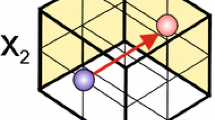Abstract
We present a comparison of three previously published algorithms for optimising the minimum energy crossing point between two Born–Oppenheimer electronic states. The algorithms are implemented in a development version of the MNDO electronic structure package for use with semiempirical configuration interaction methods. The penalty function method requires only the energies and gradients of the states involved, whereas the gradient projection and Lagrange–Newton methods also require the calculation of non-adiabatic coupling terms. The performance of the algorithms is measured against a set of well-known small molecule conical intersections. The Lagrange–Newton method is found to be the most efficient, with the projected gradient method also competitive. The penalty function method can only be recommended for situations where non-adiabatic coupling terms cannot be calculated.
Similar content being viewed by others
References
Bernardi F, Olivucci M and Robb MA (1996). Chem Soc Rev 25: 321–328
Domcke W, Yarkony DR, Köppel H (eds) (2004) Conical intersections: electronic structure, dynamics and spectroscopy. Advanced series in physical chemistry, vol 15. World Scientific, Singapore
Schoenlein RW, Peteanu LA, Mathies RA and Shank CV (1991). Science 254: 412–415
Koga N and Morokuma K (1985). Chem Phys Lett 119: 371–374
Farazdel A and Dupuis M (1991). J Comput Chem 12: 276–282
Ragazos IN, Robb MA, Bernardi F and Olivucci M (1992). Chem Phys Lett 197: 217–223
Manaa MR and Yarkony DR (1993). J Chem Phys 99: 5251–5256
Bearpark MJ, Robb MA and Schlegel HB (1994). Chem Phys Lett 223: 269–274
Anglada JM and Bofill JM (1997). J Comput Chem 18: 992–1003
Ciminelli C, Granucci G and Persico M (2004). Chem Eur J 10: 2327–2341
Olivucci M, Lindh R and Vico L (2005). J Chem Theory Comput 1: 1029–1037
Levine BG, Ko C, Quenneville J and Martínez TJ (2006). Mol Phys 104: 1039–1051
Thiel W (2007) MNDO program, version 6.1, Mülheim
Fletcher R (1987). Practical methods of optimization. Wiley, Chichester
Koslowski A, Beck ME and Thiel W (2003). J Comput Chem 24: 714–726
Patchkovskii S, Koslowski A and Thiel W (2005). Theor Chem Acc 114: 84–89
Yarkony DR and Lengsfield BH (1992). Adv Chem Phys 82: 1–71
Izzo R and Klessinger M (2000). J Comput Chem 21: 52–62
Toniolo A, Ben-Nun M and Martínez TJ (2002). J Phys Chem A 106: 4679–4689
Yarkony DR (2004). J Phys Chem A 108: 3200–3205
Murtagh BA and Sargent RWH (1970). Comput J 13: 185–194
Barbatti M, Paier J and Lischka H (2004). J Chem Phys 121: 11614–11624
Olivucci M, Ragazos IN, Bernardi F and Robb MA (1993). J Am Chem Soc 115: 3710–3721
Cui Q and Morokuma K (1997). J Chem Phys 107: 4951–4959
Yamamoto N, Bernardi F, Bottoni A, Olivucci M, Robb MA and Wilsey S (1994). J Am Chem Soc 116: 2064–2074
Page CS and Olivucci M (2003). J Comput Chem 24: 298–309
Palmer IJ, Ragazos IN, Bernardi F, Olivucci M and Robb MA (1993). J Am Chem Soc 115: 673–682
Bearpark MJ, Bernardi F, Clifford S, Olivucci M, Robb MA, Smith BR and Vreven T (1996). J Am Chem Soc 118: 169–175
Bearpark MJ, Celani P, Jolibois F, Olivucci M, Robb MA and Bernardi F (1999). Mol Phys 96: 645–652
Barbatti M, Aquino AJA and Lischka H (2006). Mol Phys 104: 1053–1060
Garavelli M, Celani P, Bernardi F, Robb MA and Olivucci M (1997). J Am Chem Soc 119: 6891–6901
Garavelli M, Vreven T, Celani P, Bernardi F, Robb MA and Olivucci M (1998). J Am Chem Soc 120: 1285–1288
Weber W (1996) Ph.D. Thesis, Universität Zürich
Weber W and Thiel W (2000). Theor Chem Acc 103: 495–506
Kabsch W (1976). Acta Cryst A 32: 922–923
Kabsch W (1978). Acta Cryst A 34: 827–828
Author information
Authors and Affiliations
Corresponding author
Electronic supplementary material
Below are the electronic supplementary materials.
Rights and permissions
About this article
Cite this article
Keal, T.W., Koslowski, A. & Thiel, W. Comparison of algorithms for conical intersection optimisation using semiempirical methods. Theor Chem Account 118, 837–844 (2007). https://doi.org/10.1007/s00214-007-0331-5
Received:
Accepted:
Published:
Issue Date:
DOI: https://doi.org/10.1007/s00214-007-0331-5




